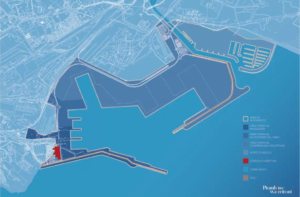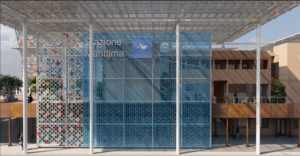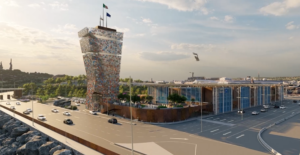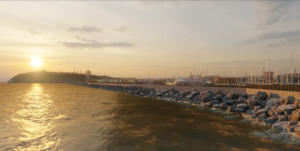A revamped and energetically upgraded Passenger Terminal facility, a new harbour pilot tower and a breakwater on the Molo Nord and Molo Batteria piers, which will feature a fake steel reed bed, coated with solar film.
The Port Network Authority aims to change the face of the port of Piombino with a mega project worth over 30 million euros.
The main objective is to improve the quality of Piombino’s waterfront by implementing innovative systems to reduce energy consumption, making buildings more eco-efficient and installing suitable facilities for producing renewable energy.
The project was illustrated in detail at the Poggio all’Agnello Resort, in the presence of the Mayor of Piombino, Francesco Ferrari, and Piombino Port’s Harbour Master, Alberto Poletti. The President of the Port Network Authority (PNA), Luciano Guerrieri, said that the project is fundamental for the port, in line with the provisions of its Energy & Environmental Planning Document and the Port Authority’s environmental policy, which aims to encourage the increased use of renewable sources in energy production and sustainable mobility.
Addressing the audience – attending, among others, were the President of Agroittica Toscana, Claudio Pedroni; the President of the Port of Piombino Company, Francesco Gazzarri; Chief Harbour Pilot, Igor Bazzano; and the President of the mooring service, Ettore Rosalba – Mr. Guerrieri pointed out how the proposed environmental mitigation measures complete the development objectives of the port area as interpreted and regulated by the Port Masterplan.
“The project we are presenting today is part of a more articulated one that aims to develop Piombino port’s passenger reception potential, making it stand out aesthetically and from an environmental sustainability standpoint,” he said, He recalled how important initiatives had been launched in the port, such as the electrification of its piers (cold ironing), recently put out to tender, or the construction of the first lot of the Chiusa di Pontedoro boating marina. “This project will give the port a new face and a new identity, attracting travellers passing through the port”.
Senior Executive at Piombino Port Authority’s Technical Management Dept., Sandra Muccetti, presented the project proposal’s identikit, assisted by architect Andrea Mannocci (of AndStudioArchitects), commissioned by the PNA with designing the project.

Three operations are planned. The most qualifying and certainly most expensive one, worth €17 million, regards upgrading the Passenger Terminal facility both architecturally and in terms of energy-saving. Basically, 13 glass canopies approximately 18 metres high will be built, which will extend the building’s roof-covered area, incorporating the connecting areas outside, over a total of 6140m2. The glass canopies will be fitted with photovoltaic cells. The building will be powered by a photovoltaic system producing 896,677.6 Kw a year. The work is in fact already financed and is covered by the PNA partly with its own funds and partly with funds from the National Recovery and Resilience Plan (NRRP).

The second project involves the construction of a new harbour pilot tower at the south-east end of the Passenger Terminal facility. It will cover an area of over 200m2. 43 metres high the tower will be coated with panels that will have a number of empty spaces inside them, so as to differentiate their visual perception. The project includes installing a photovoltaic solar plant capable of producing 14KWp on the west side of the building. The tower will also be powered by the newly installed solar photovoltaic system on the Passenger Terminal facility’s roofs, which will be able to produce 43KWp. The work will cost €5.5 million, all financed by the PNA with its own resources.

In the last phase, waterfront mitigation work will begin along the breakwater’s concrete wave-protection barrier on the Molo Nord and Molo Batteria piers. How? Through creating a series of cylindrical tubes of varying height and inclination, modelled to resemble the reeds in the coastal marine area. These reeds, 1760 in all, will be covered with modern photovoltaic film. 1089 of them will be placed along the entire length of the Molo Nord pier and 671 on a portion of the Molo Batteria pier. The work will cost €8 million, partly financed with NRRP funds.

Piombino’s Mayor, Francesco Ferrari, thanked the Port Network Authority and its project-designers for the quality of a project that, he said, pays special attention to the visual and environmental impact: “First of all, however, I would like to stress the quality of our relationship with the Port Authority; we collaborate constantly, almost on a daily basis,” he said. “I have to acknowledge how proactive the Port Authority has been in designing and completing infrastructural projects that are fundamental for our local area. The way institutions have worked together in synergy over the last few years is the starting point for encouraging the economic rebirth of this area”.
Harbour Master Alberto Poletti also expressed his satisfaction with a project that he described as innovative and original in many respects: “The port concept the Port Authority’s project design represents is not just a matter of aesthetics but responds to a multiplicity of needs. The Passenger Terminal facility is no longer conceived as simply a transit area, but as a place worth experiencing. The same goes for the new Harbour Pilot Tower, set to become the beating heart and point of reference for all the various working environments that intersect in the port.”
Once the project approval tests have been completed, the PNA will proceed with preparing the tender invitation documents for awarding the executive project design and the actual work. The plan is to publish the call for tenders within the first three months of the next year.
Translation by Giles Foster
